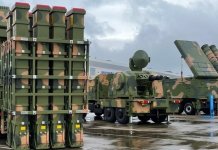As India, China border conflict persists and the possibility of another clash remains high, Indian Army Chief Gen. MM Naravane’s visit to Arunachal Pradesh comes at a time when China has completed the construction of a strategically significant highway close to the Indian border state.
Constructed at a cost of around $310 million, the highway could provide direct access to the Chinese PLA to the remote areas along its disputed border with India’s Arunachal Pradesh.
As part of its infrastructure push in the border areas of Tibet, China started constructing the highway way back in 2014 that reportedly passes through the Grand Canyon of the Brahmaputra river (called the Yarlung Tsangpo in Tibet).
The project has, therefore, raised significant concerns in India, and in part because the highway will help accelerate the efforts of the Chinese to build a major hydropower project, affecting water supplies downstream in the Indian states.
Other concerns are that of the national security for India, as the highway will allow rapid movement of assets and supplies to the People’s Liberation Army (PLA) in the event of a war with India.
General Naravane is said to have directed the troops on his arrival in the Northern sector to remain vigilant of the Chinese activities on the border during his two-day visit, which began on 20th May 2021.
In a recent statement, he had said that India will maintain its enhanced presence on the northern front, from Ladakh to Arunachal.
Will Arunachal Trigger India-China Conflict?
According to Lt Gen. J.S. Bajwa, who has served as the Chief of Staff, Eastern Command and Director General, Infantry — “compared to Ladakh, the summer sets in much earlier in Arunachal. Ladakh becomes operational only in May and June, but here, the mountains are of lesser height and there’s more greenery till the higher altitudes.”
“So, the winter ends early in Arunachal, which is followed by monsoons by the end of May, resulting in heavy rains. That is not an ideal time for the Chinese PLA to do anything. So, the period of being a little cautious was there between April-May.”
The Indian media reported that the road that China has built is a 67.22-km highway that cuts the travel time to eight hours between Pad Township in the Chinese city of Nyingchi and the Baibung Township in Medog County.
Some reports said that the highway passes through the Yarlung Zangbo Grand Canyon, the world’s deepest gorge with a maximum depth of 6009 meters.
However, according to Lt. Gen. JS Bajwa, the road doesn’t pass through the Canyon. “The road has taken a cut across the mountain range and before Namcha Barwa where the river turns, it directly cuts through the mountain ranges and joins the river just where it is about to flow into India,” he says.
Does China Hold Advantage In Arunachal?
When asked whether China had more strategic advantage in Arunachal than they do in Ladakh in terms of troop positions and slopes, Gen. Bajwa says they have developed their infrastructure up to the McMahon Line and the watershed.
“We have reached there in certain places, although they do have a little advantage here. But wherever they are coming from or their roads are coming, we are also there and we can match them in equal strength.
Where our roads have not reached, it doesn’t give them much of an opportunity. It’s just that they come and sit down and then exchange it for some other territory as we go somewhere else.
That is all they will gain,” says Gen. Bajwa who was once responsible for dealing with the India-China border from Ladakh to Arunachal Pradesh at the Military Operations Directorate.
He says that India is matching the infrastructure build-up in areas that are of concern to the country, adding that the Indian troops are present on all strategic positions, wherever there is a possibility of intrusion.
“In places where the roads are not up to the mark or there’s a roadblock due to landslides, we have created eight new ALGs (Advanced Landing Grounds). And with the aircraft that we have – the AN-32s and C-130s, and the recently inducted Chinooks, we have built up a capability of responding in all these places very fast even when the roads are not there,” he adds.
He believes that China will serve no strategic purpose in coming and occupying a small piece of territory. “You have to see the military aim and the political aim. So, what does the Chinese government want to convey to India by doing what it is doing militarily, that is what will dictate.”
India Steps-Up Border Forces
India significantly increased its troop presence along the Arunachal Pradesh border after the Ladakh clashes last year.
The violent clashes that occurred between the two nuclear-armed nations left many soldiers dead on both sides and resulted in the bilateral relations falling to a new low.
Arunachal Pradesh was at the center of the war that ensued between India and China in 1962, and the latter claims the Indian state to be ‘South Tibet.’ Security analysts have warned that it could be the flashpoint of war once again, considering the fact that China stakes its claim over the region.
The White Paper issued by the Chinese government on Friday states that the country is ramping up infrastructure in remote villages along Tibet’s border with India.
“Developing the border areas and improving people’s lives in Tibet has become important as the strategic Himalayan region shares 4,000-km long external borderline, the document titled ‘Tibet Since 1951: Liberation, Development and Prosperity,” said, Tribune reported.
China has carried out extensive infrastructural work in Tibet Autonomous Region (TAR), building railway and road networks, air routes and pipelines, communication networks, etc.




